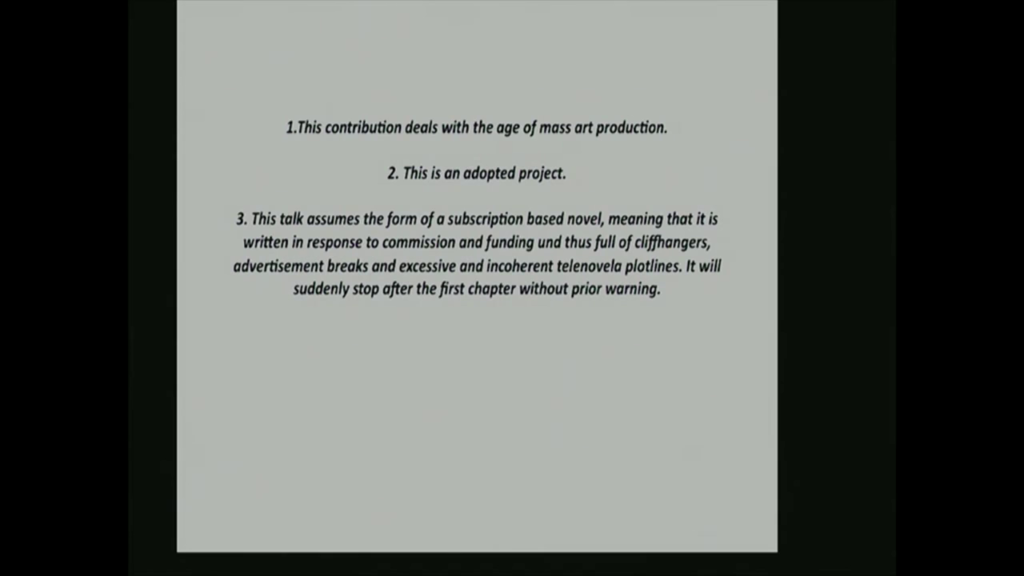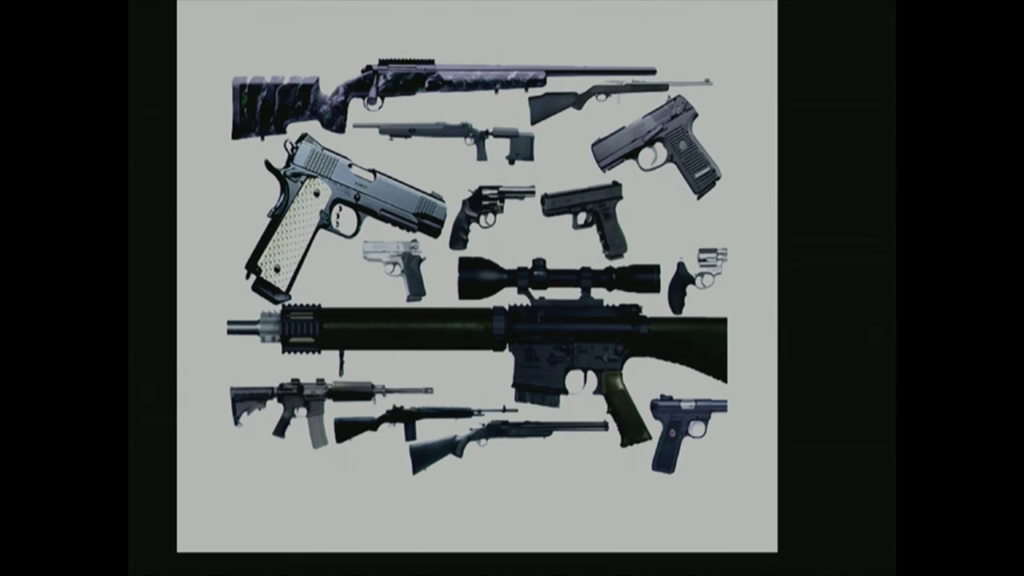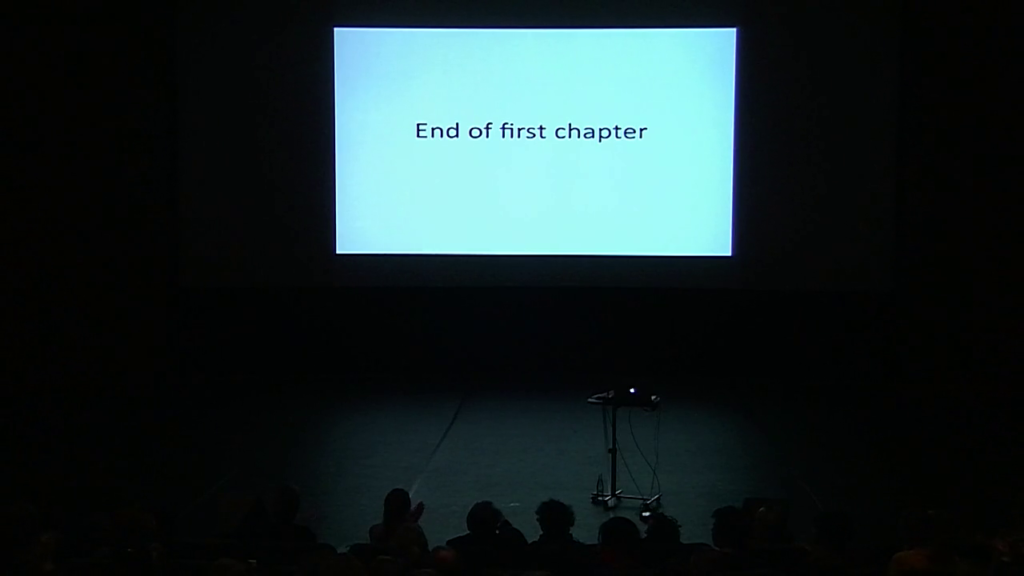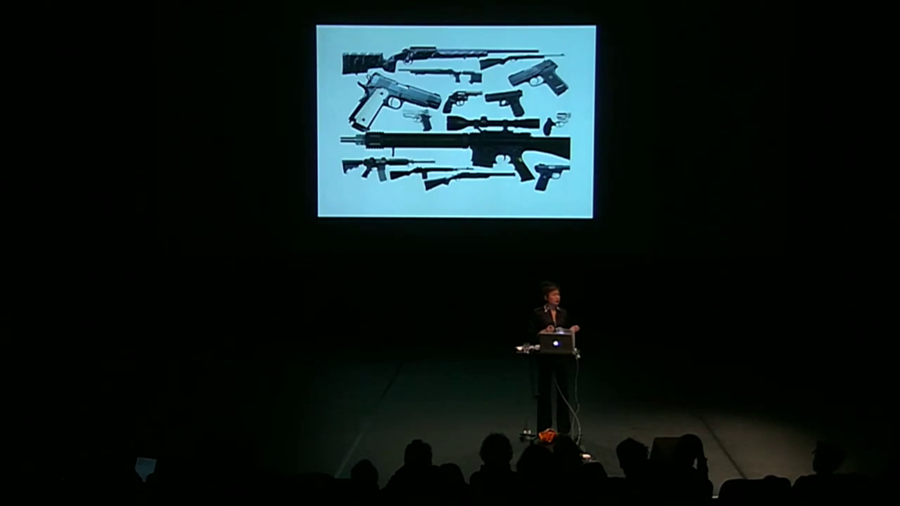Hito Steyerl: Well thank you very much everybody for being here tonight. Thanks specifically to Boris Groys for having me and for the very generous introduction. Thanks also to Maria and Former West for inviting me.

This contribution deals with the age of mass art production.
This is an adopted, not an original project.
And this talk assumes the form of a non-fiction subscription-based novel. It is written on demand, in response to commission and funding, and full of cliffhangers, advertisement breaks, and excessive and incoherent plotlines. Also it will just suddenly stop without further notice and warning.
Let’s ask a very simple question. Why are there so many art projects today? Because we live in the world of mass art production. Basically everyone is an artist nowadays. Or at least he or she has an artistic project. We can speak of a surge in the creation of art. The production of art is proliferating. We live in the age of mass art production.
How did we get to this point? Because art production used to be one of the most arcane activities, reserved to male masters who had to invest a lot of time and effort to develop their abilities. So how was this activity so thoroughly popularized? How come that basically anyone today can rightfully claim to produce art? And I would like to compare this to one major other technological and social transformation, namely the invention of firearms.

This process stretched out over many centuries and also continents, from the invention of gunpowder in the 9th century, to the invention to the Colt revolver in 1836, to the AK-47 and beyond and beyond. So, initially it was Chinese alchemists and they were looking for an elixir for immortality. And of course they ended up inventing the exact opposite of that, no? An elixir for immediate mortality, so to speak.
And in the long run this produced a massive democratization of violence, which one could claim ran in parallel with the violence of democratization as such. So there was no more lengthy and costly training needed in order to learn how to kill anyone. One didn’t need anymore horses and swords and expensive equipment and training. With the invention of the Colt revolver, any idiot could kill anyone else in a very cost-efficient and effective way. It was cheap, mobile, portable, bullets were standardized—one had just to pull the trigger. The invention of firearms is probably one of the most important examples of deskilling in human history, and ultimately it completely overturned the social order.
Something similar in my mind happened with art production over the 20th century. Essentially, Duchamp’s urinal and Malevich’s square and advertisement and everybody’s contributions on YouTube dramatically shortened the amount of training and material resources that people needed to produce something that could legitimately pass as art.
The emergence of reproductive technologies of representation had a specific impact on these developments. It’s perhaps no coincidence that early photo equipment was advertised in the same way as Colt revolvers. Kodak’s early roll film camera, Brownie, had the tag line “You pull the trigger, we do the rest.” So shooting and deskilling in image production went hand in hand, and it’s definitely no surprise that nowadays in the age of artistic mass production, armed people are also joining the growing league of artists.
Let me give you one example of another project—actually several—I was told when recently I was stopped on a checkpoint on a remote dirt road. We were politely led away by a group of lovely people wearing shiny AK-47s. Their commander was called Comrade X, and the first thing he was interested in was not ourselves, obviously. It was an advertisement leaflet from a local video camera store.
Forty years ago one might have asked oneself whether one should profess allegiance to Lenin or to Mao or maybe just diplomatically toast world revolution. But in the age of mass art production the question is no longer between Lenin and Mao but between Canon and Panasonic. And toasting world revolution is replaced by the only universally-applicable question today: Comrade, what is your art project?
So I really want to add now I’m not making this up. You will see that I couldn’t make this up because it’s much too inconvenient for me to make up, you know. It’s really based on a real conversation. This is what Comrade X replied to this question.
My name is X. I was born in 1971 and grew up in a political environment. I joined the guerrilla in 1991 and was active as a city guerrilla. I was arrested in mid 1992 and spent ten years in jail. Afterwards I became a guerrilla again. At the end of 2001, immediately after release I went up the mountains with the guerrilla. It is the most beautiful way to be a revolutionary.
Les Misérables is one of the books that influenced me most in my life, because Victor Hugo tells us in a literary form about social and ideological contradictions. He’s a romantic. The tradition of Descartes and [?] had a rationalist and positivist scientific perspective on society. So these ideological contradictions between romanticism and positivism reflect on one of the characters in the novel called Inspector Javert. And he’s torn between contradictions between his conscience and rationality. He ends up killing himself. This is his situation. And this is Comrade X’s art project. “I am planning to write a sequel to Les Misérables in which Javert does not killed himself. This is my dream and I hope that I will realize this one day.” This is his first art project. He told us to other and he asked us to basically take care of it because he had too many aerial attacks on his hands at that time.
So I will tell you in one minute how one could possibly go about realizing this plan, and I told you it’s completely unlikely that I made this up because I never would have made anything up which has to deal Les Misérables because what do you do? You are given this topic, and oof. So it does not really seem like a sensible topic for a contemporary art project. No one ever read the novel, and the recent film killed off any remaining desire to ever want to deal with this work. But you know, I was given this task and I think actually that X’s idea is very fascinating and very illuminating if we think it through a few detours.
And first let’s return to the initial question. The age of mass art production, the era in which almost every human being has an art project. And I was comparing this to the spread of firearms. Which has not only led to a democratization of violence but it also changed the world ultimately. Because feudal orders were replaced with industrial ones. Feudal hierarchies were overturned, overthrown. And of course this is also embedded in to many other shifts—technological, political, social, economical, historical, and so on. But I think the spread of firearms definitely plays a role in that.
And now I’m asking myself what are the possible social consequences for mass art production. Are there any potential effects, similar effects, for a similar restructuring of social hierarchies? Can we project how and if this popularization of aesthetic production might overturn or reconfigure in some way the current order?
So on the one hand, mass art production means that art has finally dissolved into life, or more precisely I think that all of life has dissolved into art. But there are also much more prosaic, so to speak, side-effects of this developments. There’s a lot of artists and people with art projects now and only a fraction of them can support themselves by their practice. And a sizable part of the rest has become part of a group which is not really supposed to exist nowadays, the group of the educated urban poor.
On the other hand we are also faced with a situation in which the same group of people forms a substantial part of many urban social movements, and in some cases even the main part. They are not taken seriously because they do not correspond to any traditional idea of what a social group is supposed to look like and how it’s supposed to represent itself. But many of them have taken part in the uprising over the past few years, in rebellions that will maybe not form for more than a tiny footnote in history, one of the many failed attempts to change things. Perhaps like in 1848 if we’re lucky. Or in 1871. I don’t think so, but perhaps something like 1832.
Why 1832? Do you know what happened in 1832? This is a year but has been almost forgotten in the history of disobedience and revolutions. But it has been a year of massive student unrest, uprisings, deadly massive violence in the streets against a regime that had already survived its time yet would go on to live for another seventy years. You think I might be talking about one of the recent stolen revolutions that promised a spring that actually never came.
What I’m actually talking about, the setting of Les Misérables by Victo Hugo, because in 1832 there was a massive armed rebellion in Paris by tricksters, by spammers, by artists, even. Temporary workers, students, teenagers, kids, other motley crowds of people which did not yet correspond to what later became formed as a proletariat. This revolt seemed to be in the vain, It was quickly dispersed, followed by other gallant but equally unsuccessful revolutions.
So now we are sort of back with Comrade X’s project, giving it another twist by aligning it now with the tradition of defeated uprisings. But then again is this really enough to make it worth the effort? One has still to admit Les Misérables is a terrible book, no? It feels like an oversized literary telenovela which has cliffhangers every thirty pages to accommodate advertisement breaks. The plotlines are completely impossible, convoluted, and barely hanging together by coincidence and they read as if they also got paid per page and thus just rambled on indefinitely. Its form is certainly affected by the serial newspaper novels of the time, which appeared in installments and combined new industrial printing technologies and mass readership. This rambling pulp fiction, basically, which was written on commission, thus basically anticipating the form of the TV soap.
But this also brings in another idea, because each of these chapters had to so to speak vie for the survival of the whole series. Because only if every chapter was successful the series would be continued. And if not, the commission would simply be dropped. So each chapter was so to speak a renewed job interview. It was another pitch for the same project. It was a permanent public audition to get the next chapter funded, to realize the project step by step, or rather check by check as an add-on modules.
So the novel in fact consisted of a series of pitches for itself. It was an auto-audition, so to speak. And the pitch itself became part of the drama. And I think that this formal level, not the shootout at the barricade shot in 4K with singing Hollywood actors, that this formal level is the most contemporary political level of Les Misérables. And this is embodied by a stellar performance—not in the recent one by Anne Hathaway who got an Oscar for her performance—but by Susan Boyle, if you remember. The rendition of the most impressive song of the musical Les Misérables, which is called “I Dreamed a Dream.” And it was a sung on the casting show Britain’s Got Talent.
And I think that it’s here that we see an unexpected aspect of Comrade X’s project emerge. Because “I Dreamed a Dream,” this song, is the anthem of single working moms all over the world. It’s sung by someone who was abandoned by the father of her child. She’s left to fend for herself. She has childcare problems. She falls into the hands of a scammer. She becomes a prostitute and so on. It was really complicated. But thus she becomes the tragic heroine of reproductive labor in the age of devastating affective wages, scams, catastrophes, of middle-age women who have no time to be cool because they’ve got to do the work, they’ve got to face the shame, they’ve got to wipe the tears. I will show this clip. I’m sure you have seen it already but anyhow.
https://www.youtube.com/watch?v=deRF9oEbRso
So I think from this stellar rendition, it is really obvious that there is another species of misérables around, not of stage but on stage. The contemporary misérables are also those who are waiting in the curtains to be casted, to audition, to pitch. They are the crowds who are too fat, too awkward, too old, too accented, and who nevertheless go perform in front of posh juries in order to be voted up or down, to be ridiculed, to be dismissed, to be fired. To present their art projects, their dreams, or their songs, they are the wretched of the age of mass art production, facing judges with bleached smiles and anorexic cleavage. And of course, behind these and even more invisible, there are many more who are mining the minerals we need for these freelance laptops, who are weaving the H&M clothes on display at job interviews. They are the ones that fight in the mountains, dreaming of artworks, and those that crouch to die behind barricades painted in trompe l’oeil patterns.
So the misérables in the age of mass art production is the rabble waiting to be discovered by castings, job interviews, competitions, through calls for papers, pitches, talent, fairs. They are pleading to be called out in front of juries, assessed, ridiculed, lured by the spam promise of instant celebrity, fame, and by annual speedboat rides with Vladimir and Naomi.
We are auditioning, interviewing, pitching vanity art projects, taping protests in gonzo porn fashion, and announcing our suicides on Facebook. And thus we realized that we too are still caught in the contradictions of Les Misérables, the romantic promise of a fair chance on the one hand, and the rational probability of this dream being dismissed. How does one reconcile these contradictions? And many do, as the Inspector Javert in Les Misérables, by taking their own lives, unable to reconcile the contradictions, the shame, the reality of never-ending casting, never-ending issues with childcare, reproductive labor, abandonment, doubt, and the drag of dreaming on.
So now we have seen Les Misérables also teaches us that the same rabble can rise and take to the barricades in 1832, 2011, maybe even for the future, claiming for a spring that keeps us waiting.
So now at the end I suggest to come back to Comrade X’s art project for a second time, for the last time. And this is how I suggest to realize [it]. Imagine that this is now me, not Susan Boyle, wearing a 19th-century period costume on an empty film set, and we will green screen in a stage barricade which is made of museum benches and discursive architecture lounge. And we will throw in a lot of extras made up to look poor and miserable and hollowed. And each of them is of course an artist who is doing some job on the side to be able to realize his or her own project. And all these extras are armed with AK-47s. They are playing student militias about to get slaughtered at the barricades and then forgotten, only to be rediscovered by a terrible movie.
And in this setting, I’m pitching Comrade JR’s second project to a jury, and this jury is in fact you.
[The following is recited as the music of “I Dreamed a Dream” plays and its lyrics are displayed via projector]
This is my second art project, “Chasing Spring.”
We are guerrilla, and my second project has its point of departure in the fact that we are guerrilla who live, think, and feel. The idea for a documentary, which I developed, will connect the life of the nomad to the one of the guerrillas. You my friends are also documentary filmmakers. We share this. Nomad life is very intense here. The nomads go down to the valleys in winter to warmer places. In summer they go up to the mountains.
The nomads have a saying, “each place has its spring.” This saying describes the life of nomads. This means they follow spring. The nomads follow spring from the plains to the mountains, and from the mountains to the valleys.
The guerrilla bring spring to social life. Before its inception, it was deep winter. In winter all contradictions are frozen. But with the guerrilla, spring came again and the talents of human beings were rediscovered.
Most guerrilla and nomads are chasing spring. I want to tell this story, Chasing Spring.
So at this point, the extras will audition to play either nomads or guerrillas. They will audition for these roles, they will show their talent to the jury. That is, if they pay the audition fee they get the chance to be discovered at this point. They will also have to prove that they are able to handle the AK-47 by firing some rounds on specialty marks specifically designed by Zaha Hadid for this occasion.
Is there any talent here, by chance, that would like to audition now, so you will get the chance to submit your own art project, either in the role of nomad or guerrilla? And the jury will select one of these submissions to be published on a special web site accessed via a direct link from the Venice Biennale.
One day, I’ll manage to realize this project. I wrote down a part but at the moment practical life doesn’t allow me to realize this at the moment. I told Tina and Hito this story, and I hope they will realize it. I hope we will realize it together. It is the best and most beautiful to collaborate. I hope we will experience this joy together.

